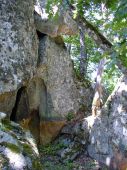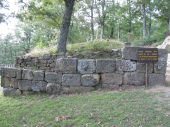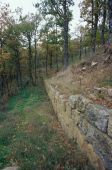The human presence in the territory of Gallipoli Cognato has very remote origins, as shown by the findings found in the area of Monte Croccia (particularly in the Grotta di Pietra de la Mola) dating back to the Neolithic age (12,000 - 8,000 years BC). It is likely that even in later times there have been more or less irregular forms of human settlements, as evidenced by the findings at Tempa Cortaglia (near Accettura) of cinerary urns dating back to the Bronze Age (4000 - 2000 years BC). Between 1300-1200 B.C. the first substantial immigrations from Anatolia, now Turkey, organized into tribes, the Lykis, who gave the name to the Lucania region and who settled in the upper and middle Basento valley, are the leaders.
Database of the historical presidium of the Park
The database is available to learn about the archaeological and architectural structures surveyed by the Park..
The first stable settlements can be dated around the VI - IV century. B.C., when social groups of Oscan-Samnite origin founded the Lucanian town of Croccia Cognato. Built at 1,149 meters high and defended by an imposing city wall of more than 2 km in length, the residential area has a construction technique certainly inherited from the Greeks. In fact, the Lucanis borrowed from the Greeks the construction techniques of the defence works, made of blocks of squared stone that formed walls several kilometres long.
Starting from the 3rd century B.C. the supremacy of Rome determined the decline of both the Greek and the Lucan civilizations. Of the Lucanian town of Croccia Cognato and of the other fortified centres, the traces were gradually lost, until the whole area was used exclusively for the summer grazing of the herds of Roman farms.
In the centuries that followed the end of the Roman Empire, Basilicata was troubled by the invasions of barbarian populations coming from Northern Europe and it was only starting from the 10th century AD. that this area returned to be permanently populated. For many years, the Byzantine monks and the Saracens lived together with the local populations sheltered in what probably was the medieval village of Gallipolis, whose remains can be seen on the top of Timpa Castello near the "Palazzo". S. Guglielmo from Vercelli founded the “Palazzo”, an ancient convent, around 1100 together with the convent of S. Maria di Serracognato (now known as Cognato Chapel).
The frequent famines and plague epidemics that characterized the following centuries (in particular the 14th and 15th centuries AD), caused a considerable depopulation of many centres in the area and this situation continued throughout the seventeenth century; only starting from the 18th century it began to witness a slow recovery of the settlements. The decisive century for the territory of Gallipoli Cognato and of the Lucanian Dolomites was certainly the 800th; in this period, in fact, the whole area underwent a process of anthropization whose signs are still evident today.
Among the major initiatives, we mention the establishment of the State Forestry Corps in the former Palace convent; the construction of numerous forest barracks, nurseries and farms, the cultivation of land that until then had been of marginal importance. In fact, numerous are the Jazzi present in the territory of Accettura, bearing witness to the importance of sheep and goat breeding. Together with the inhabited centres, therefore, significant rural settlements were developed in the territories of Accettura (Valmiletta, Valdienne) of Pietrapertosa (Castagna, Casieri, Abetina) and of Castelmezzano (Calcesia), giving the landscape an entirely original aspect, which still constitutes singular and peculiar element of these places.




















 Il presente sito si ispira alle nuove linee guida di design per i servizi web delle PA
Il presente sito si ispira alle nuove linee guida di design per i servizi web delle PA